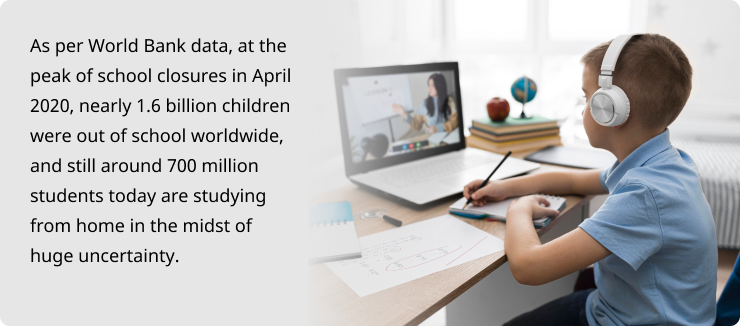Why the Education Sector Needs Digital Communication Tools
In 2020, the covid-19 pandemic brought the world to a grinding halt. Offices, shopping centers, restaurants, and travel closed down overnight as people hunkered down in the safety of their homes. A massive fallout of the pandemic was its effect on the global education sector. Schools, colleges and other institutions had to stop operations, affecting millions of learners worldwide. Class schedules and exam routines went haywire, jeopardizing studies and creating great uncertainty among students at the cusp of their careers. Then there was the huge risk of many students from low-income families completely dropping out of the education system. How would authorities ensure that such vulnerable students continue their educational pursuits?
The education sector had to act quickly — because shutting down learning was simply not an option, and neither was asking students to risk their safety and attend school. They needed to ensure continuity in learning as well as create channels of easy communication between different stakeholders. The most viable option now was to conduct virtual classes. Taking cue from other sectors like auto, retail, healthcare, etc. which had pivoted to digital almost overnight, the education sector also turned to digital technologies to enable e-learning. They bolstered their web presence, set up online classes, and deployed tools like email, live chat, SMS, and even WhatsApp to connect all the different stakeholders of the system — students, teachers, parents, and administrative staff. Many institutes and even governments provided needy students with smartphones and tablets so as not to cause barriers in education.

What Specific Problems Did Digital Communication Platforms Solve?
When it came to going online, there were a number of questions before educational institutes.
- How would they make it easy for parents to reach out to them for day-to-day queries?
- How would they ensure that parents trusted the information they sent out as coming from an authentic source?
- How would they manage the influx of queries from students and parents which was putting undue burden on their administrative and teaching staff?
- How would they create support groups for college students who would miss out on meeting their peers physically?
Leveraging digital communication platforms using channels like WhatsApp (with its two-way communication) has helped many educational institutes address the above issues. WhatsApp is one of the best mediums to broadcast messages to many candidates at once, saving time, money, and hassle.
Establishing verified WhatsApp Business accounts has enabled institutes to create a sense of trust and authenticity when it comes to sending out official announcements. They can share proactive alerts related to on-campus safety, covid protocols when attending physical classes, information about class routines, event reminders, academic progress reports, etc. all on the app. Secure end-to-end encryption ensures privacy and sharing of confidential information like a student’s grades. Students or parents can also reach out easily on WhatsApp to get their queries answered.
WhatsApp’s rich multimedia messaging capabilities have especially empowered admissions teams to share a variety of documents including brochures, campus videos, admission forms and guidelines, deadline reminders, and more on the app. They can even leverage the app’s location sharing capabilities to share locations of exam centers. Its instant automated responses can help admin staff send out greetings, share general FAQs, etc. with little to no human intervention. Separate WhatsApp groups for each subject enable teachers to share educational materials with students easily.
Live chat on an institute’s website is also a powerful tool for institutes to address student queries quickly and effectively, whether entirely via automated bots, or through a judicious mix of human agents and chatbots. Educational institutes that have deployed digital channels like WhatsApp, live chat, SMS, and emails to engage with students in these turbulent times have seen enrollments go up and helped students sail through with relative ease.

Benefits of Using Digital Communication Platforms for the Education Sector
Leveraging digital platforms for Education industry has solved a number of issues.
First, it has ensured student safety as they would not have to step out of their homes for classes.
Second, it has bridged the geographical divide — students who might have had to move back to their home towns could still access the class online.
Third, with smartphones being relatively cheap and ubiquitous, most students can easily have access to study materials and not fall behind peers.
Fourth, information can be shared with all students / parents across digital channels in real time, unlike when students would have to physically reach their campus to find out information related to exams, class schedules, etc.
Fifth, automation technologies have reduced the workload for administrative teams and enabled them to focus on more urgent issues requiring human intervention.
Sixth, it is way easier and faster for a school/college/university to simply send out a note on a student’s progress to their parents on a messaging app rather than conduct lengthy phone meetings.
While the pandemic may linger on for some more time before it finally takes leave, the changes it has set forth in motion are here to stay. Experts believe that even when schools and colleges finally open up, a new hybrid model of education will emerge, where technology will become an integral component of education. Messaging technologies will continue to remain a vital component of education due to their easy reach, ease-of-use, and real-time communication capabilities, and institutes that leverage them earlier will always have the first-mover advantage and retain their competitive edge.




![[photo]](https://edna.io/wp-content/themes/edna/images/authors/rajrupa-ghoshal.jpg)
![[icon]](https://edna.io/wp-content/themes/edna/images/authors/ico-linkedin.svg)